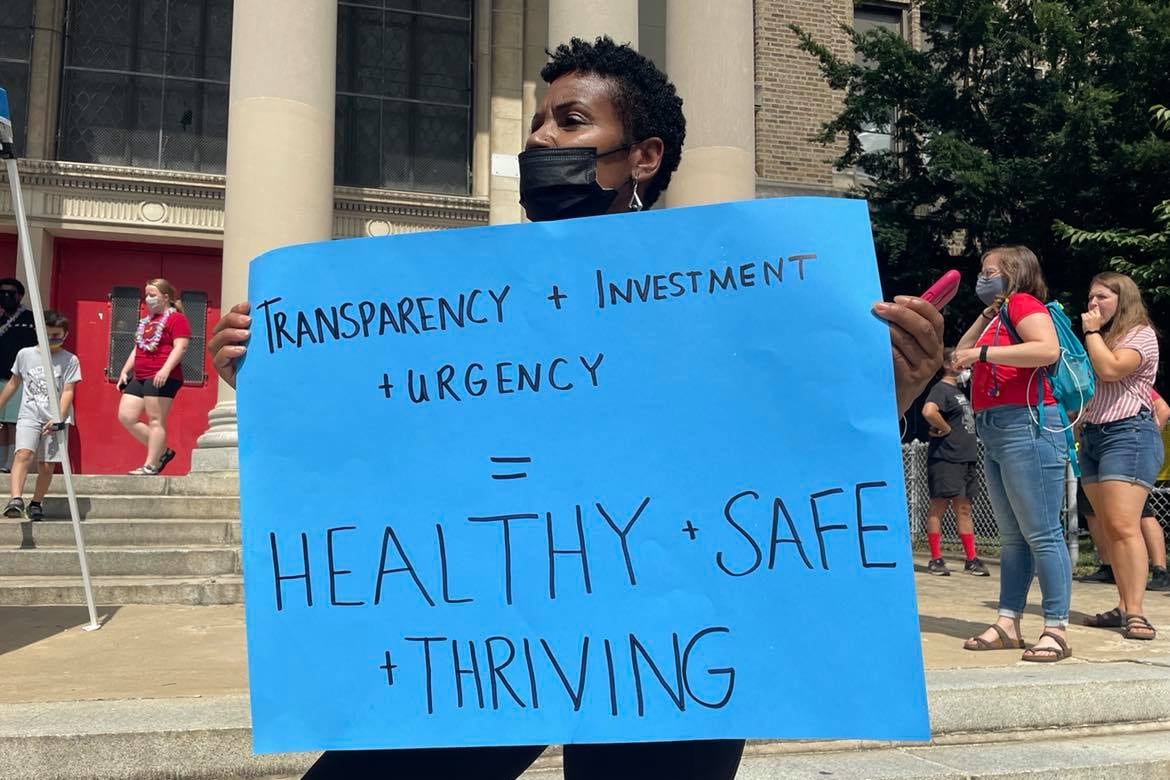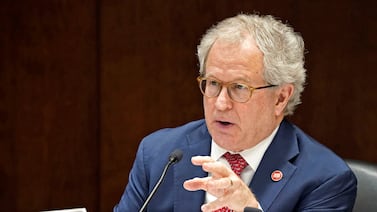Editor’s note: This article was updated to reword material that appeared verbatim in a Philadelphia school district press release.
One of Principal Joanne Beaver’s biggest concerns during the pandemic is having enough money to cover personnel.
“I have difficult decisions to make every year around positions,” said Beaver, who’s head of the High School for Creative and Performing Arts in South Philadelphia. “There are two things that lead my thinking in terms of budget — the well-being of students’ safety and equity.”
Beaver’s experience is a microcosm of what educators in the city’s public schools have gone through during COVID. Yet they’re getting some support through the third and latest round of federal COVID relief money for K-12.
When deciding how to use that $1.1 billion, which comes from the Elementary and Secondary School Emergency Relief (ESSER) fund, the Philadelphia district is prioritizing academic recovery, social and emotional support, building upgrades and repairs, and curriculum development. Of this third round of ESSER, the district is dedicating $350 million to academic recovery and learning acceleration, the single-largest amount for any category of spending, according to a breakdown of the funding provided by the district.
The money could provide a crucial boost for the district at a very difficult time for city schools; last year, Superintendent William Hite called the money “unprecedented.” Yet the aid hasn’t totally assuaged long-term worries about the district linked to the pandemic and other issues.
Mary Sanchez, principal at Warren G. Harding Middle School in the Northeast, told Chalkbeat the money has been a relief for her.
The school has used the money on different after-school programs like tutoring for English language arts and math. “We had a chess club, a Scrabble club, a drama club, LGBTQ club, a step dance club and a girl support club, so we had at least 10 to 15 different extracurricular programs after school for our students to participate in,” Sanchez said.
Beaver is using her school’s share of the money, $119,000, to address staffing needs such as the hiring of a new assistant principal, as well as social and emotional learning for students who’ve endured prolonged school closures, various trauma, and disruptions to their classwork since March 2020.
Districts must use or obligate the money over a three-year time span. In two previous rounds of federal COVID aid, the Philadelphia district received a combined $512 million.
Breaking down what will be spent and where
The first round of the district’s ESSER funding from early 2020, about $112 million, was intended to help schools confront the early stages of the pandemic by preventing staff layoffs, among other things. And $400 million for Philadelphia schools in the second round of ESSER from late 2020 paid for everything from cleaning and protective equipment to technology.
The district must spend or otherwise commit funding from the third round of ESSER by the end of September 2024.
Of the $1.1 billion, Philadelphia schools will use $350 million to support educational recovery and accelerate learning. Parents and educators have been concerned about learning loss throughout COVID; students made the transition back to in-person learning last August, after 18 months of virtual learning. Many students have also been absent, making teaching and learning a challenge.
According to Uri Monson, the district’s chief financial officer, this pot of money will pay for summer learning programs to help students get back on track, and it will also support after-school programs, before-school programs, tutoring, and academic clubs. Some funding will also go towards retaining staff, like teachers as well as administrators, who will in turn help students recover academically.
“There’s no way the students are going to recover [without more help], so we have to have the staff there,” Monson said.
Another $325 million is dedicated for improving facilities conditions across the district to address well-documented problems with ventilation and asbestos. Teachers last year threatened to boycott work over these and other building safety concerns.
The district plans to use some of this money on ventilation and HVAC projects, and will also replace three of its school buildings: Lewis C. Cassidy Academics Plus School, Thomas Holme Elementary School, and AMY (Alternative Middle Years) at James Martin School.
“We have identified three buildings that will primarily be funded through this, which are either being completely rebuilt or either brand new buildings, basically completely rehabbed. This was just approved by the board a few months ago,” Monson said. “So that’s three essentially new schools.”
Part of the $325 million for facilities will pay for 800 new hydration stations that provide chilled, filtered water. The district has a goal of one filtered hydration station per floor for every 100 students in its 269 school buildings.
According to Monson, some of this money is going for some asbestos-mitigation projects and to strengthen an asbestos response team, as well as a lead paint response team with the goal of getting all buildings certified as lead-paint free in the next two years.
In addition, $150 million is to support social and emotional needs of district students. Gun violence has created an urgent crisis for many Philadelphia students, and social-emotional services have in turn become critical to support students experiencing related trauma. The district plans to increase its level of climate support services, including peer mentoring and social workers.
“Improving the [counselor-to-student] ratio is a big one … you have more counselors in the system, more climate managers in the system who are dealing with day to day issues,” Monson said.
The district also aims to use a slice of the $150 million for social and emotional priorities to hire staffers to improve school climate. They would work a few hours a day and hail from the school’s surrounding neighborhood, and would provide community support for students when other adults are not around.
“If we’re seeing a school that is showing signs of poor attendance, behavioral issues, climate issues, we can send those teams in to address the issues, provide support to the staff that’s there and help the school deal with whatever the relevant issue is,” Monson said.
A portion of this money will go toward technical support for families and helping to provide internet service for households that can’t afford it and increase the number of psychologists and therapists.
Finally, the district will use a portion of the relief money for curriculum development and to create new K-8 math and literacy frameworks, in order to support student learning. The cost will be around $100 million.
‘I never want to make promises I can’t keep’
Monson said that while ESSER relief money has helped prevent the district from shuffling teachers between schools to prevent staffing shortfalls, he still expects a budget shortfall of over $100 million in the district in fiscal 2026.
Some of the district’s response to staffing issues, such as a spike in midyear teacher resignations, led to responses that also included the use of federal COVID aid. These included signing and retention bonuses for teachers and other staff, as well as payments for people to get their commercial driver’s licenses so they could work as school bus drivers.
School officials also want to align the district’s use of ESSER money with the Board of Education’s broader “goals and guardrails.” Equity is a major component of the board’s goals and guardrails as well as rules for spending ESSER money — both aim to prioritize students in “high poverty” areas.
Just over a year ago, the district solicited feedback from the community about how it should use the $1.1 billion infusion from the federal government. Some of the top priorities that emerged from the public’s 11,700 responses, such as improved ventilation and air conditioning systems in schools and additional mental health services, correspond with how the district has decided to use the aid.
Even when it comes to staffing, the COVID relief doesn’t cure all ills or meet everyone’s demands. For example, this school year, principals have been advocating, so far unsuccessfully, for the addition of at least four permanent positions at their schools — including an assistant principal, full time reading and math coaches and a special education monitor.
Despite the additional aid her school is getting, Beaver, the principal of the creative and performing arts school, is not making grandiose pledges about what it will mean down the road.
“I’ve been doing this for 16 years in three different school communities and it has always been a year to year decision,” Beaver said. “I don’t project into the future, because I never want to make promises I can’t keep.”
Bureau Chief Johann Calhoun covers K-12 schools and early childhood education in Philadelphia. He oversees Chalkbeat Philadelphia’s education coverage. Contact Johann at jcalhoun@chalkbeat.org.





